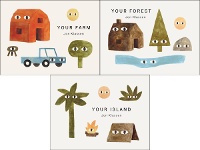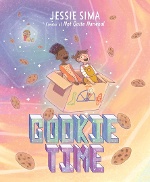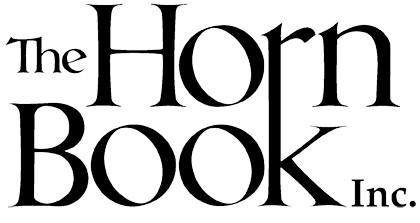2025 Summer Reading: Picture Books
Need suggestions for beach reading or books to bring to summer camp? Each of our lists — for all age ranges and including fiction, nonfiction, folklore, and poetry — contains thirteen selections (a baker’s dozen!), all published 2024–2025 and ideal for the season. Grade levels are only suggestions; the individual child is the real criterion.

Beginning Readers and Primary Grades | Intermediate | Middle School | High School
Picture Books
Suggested grade level for all entries: PS–2
 Wind Watchers by Micha Archer (Paulsen/Penguin)
Wind Watchers by Micha Archer (Paulsen/Penguin)
Three children experience the invisible power of wind over the course of a year. They begin with a direct question to Wind itself: “How will you blow today?” Each subsequent double-page spread provides an answer. The lyrical, poetic language is easy to read aloud, and Archer’s masterful use of acrylic ink and paper art showcases a variety of techniques, compositions, and perspectives, with each page-turn inspiring wonder. 32 pp.
 A Sleepless Night by Micaela Chirif; illus. by Joaquín Camp; trans. from Spanish by Jordan Landsman (Transit)
A Sleepless Night by Micaela Chirif; illus. by Joaquín Camp; trans. from Spanish by Jordan Landsman (Transit)
In this vibrant, absurdist Argentinian import, young Elisa cries so loudly that all the neighbors in their apartment building are disrupted. Increasingly creative attempts at soothing her blur the boundaries between reality and fantasy. A humongous fart finally relieves her — and blasts the apartment complex up like a rocketship and then back to Earth. The rich, humorous text is full of similes, and the illustrations appear to be rendered with markers, offering a layered and textured style. 48 pp.
 Duckie & Snaps: We Cannot Be Friends by Ame Dyckman; illus. by Tim Miller (Orchard/Scholastic)
Duckie & Snaps: We Cannot Be Friends by Ame Dyckman; illus. by Tim Miller (Orchard/Scholastic)
Duckie, wide-eyed, loquacious, and looking for a friend, hatches next to Snaps, a crocodile who’d just as soon beat it. Duckie lays out a case for staying to play, but an adult-looking croc almost ruins things: “We. EAT. Duckies!” A creative culinary solution leads to the promise of lasting friendship and appetite satisfaction. Digitally colored pen-and-ink illustrations feature crisp black lines, bold hues, and slapstick-y interactions between an unlikely duo. 40 pp.
 Worm Makes a Sandwich by Brianne Farley (Putnam)
Worm Makes a Sandwich by Brianne Farley (Putnam)
Worm acknowledges that he can’t actually make a sandwich — what Worm can do is eat garbage and poop it out to make a nutritious base for dirt that will grow the sandwich’s vegetables. This nonfiction ode to compost is neither preachy nor grody, and Worm is a charming guide to the growing season. Lush, cheerful illustrations are complex but not busy, and plants and critters are labeled with hand-drawn lettering. 32 pp.
 Big Bike, Little Bike by Kellie DuBay Gillis; illus. by Jacob Souva (Harper/HarperCollins)
Big Bike, Little Bike by Kellie DuBay Gillis; illus. by Jacob Souva (Harper/HarperCollins)
Duck finds a “free” bike, but it’s too big. It’s also too small for a rhino and too slow for a cheetah. Eventually, a warthog crashes the bike, and a human parent fixes it up for their child, who years later puts it out with a “free” sign for another child to find. The jaunty, poetic story uses a light touch to provide a layered look at sustainability and, most of all, the appeal of bicycling around town. 40 pp.
 A Forest Song by Kirsten Hall; illus. by Evan Turk (Random House Studio/Random)
A Forest Song by Kirsten Hall; illus. by Evan Turk (Random House Studio/Random)
This cento (a poem composed of passages from other writers) pays reverent tribute to the natural world, weaving together the words of poets such as Emily Dickinson, Mary Oliver, Philip Larkin, Harriett Annie Wilkins, and many more. Hall’s mastery of rhythm and flow is mesmerizing, transforming the borrowed words into a cohesive and enchanting experience. Turk’s color-saturated, light-infused illustrations bring the book-length poem to life. 40 pp.
 Your Farm | Your Forest | Your Island all by Jon Klassen (Candlewick)
Your Farm | Your Forest | Your Island all by Jon Klassen (Candlewick)
“This is your sun. It is coming up for you.” Thus begins each of three original board books, with subsequent spreads introducing other features you’d find in the setting and adding them to the scenes. Brief, straightforward texts, sparsely populated pages, and expressive eyes for each object in the illustrations mimic and encourage a toddler’s drawing activity. In short, Klassen has crafted three unassuming master classes in picture-book making for the youngest listeners/viewers. 24 pp. each.
 Downpour: Splish! Splash! Ker-splash! by Yuko Ohnari and Koshiro Hata; trans. from Japanese by Emily Balistrieri (Red Comet)
Downpour: Splish! Splash! Ker-splash! by Yuko Ohnari and Koshiro Hata; trans. from Japanese by Emily Balistrieri (Red Comet)
Vivid illustrations and enthusiastic prose evoke the surprise and awe of a summer rainstorm in this Japanese import. A child narrator scowls at the weather; it’s too hot to have much fun. But dark clouds roll in, rain falls, and the child is enchanted by the sights, sounds, and sensations of the sudden deluge. Shifts in visual perspective invite viewers to share in the delight. A joyful and refreshing multisensory experience. 40 pp.
 All at Once upon a Time by Mara Rockliff; illus. by Gladys Jose (Abrams)
All at Once upon a Time by Mara Rockliff; illus. by Gladys Jose (Abrams)
This clever mash-up of folk and fairy tales creates a whole new twisted plot: “Once upon a time (now, tell me if you’ve heard this one before)…” The key to reveling in this comedy is in that parenthetical phrase: it’s not, for instance, Rapunzel in a tower but rather a princess with an extremely long nose that grows when she fibs. Bright cartoon art with exaggerated perspectives heightens the fast-paced adventure and the humor. 48 pp.
 Chooch Helped by Andrea L. Rogers; illus. by Rebecca Lee Kunz (Levine/Levine Querido)
Chooch Helped by Andrea L. Rogers; illus. by Rebecca Lee Kunz (Levine/Levine Querido)
Narrator Sissy’s little brother Chooch is two and wants to “help.” When he tries, things do not go well. Sissy yells, and Chooch cries. Sissy’s parents remind her, “Chooch learns by watching. You’re one of his most important teachers.” This picture book, whose creators are both citizens of the Cherokee Nation, highlights the joys and challenges many older siblings face as younger ones begin to mimic them. Kunz’s striking mixed-media art complements Rogers’s loving family story. 48 pp.
 Cookie Time by Jessie Sima (Simon)
Cookie Time by Jessie Sima (Simon)
Kat and Ari love baking cookies with Grandpa but struggle with the wait while the treats are in the oven. So they build a time machine to skip ahead to when the cookies are done — but they miscalculate…multiple times. Sima has fun with imaginative details: the children build the time machine out of a cardboard box, a spring, and their dog’s ball. A warm intergenerational story about cherishing the present moment. 56 pp.
 When I Move by Carole Boston Weatherford; illus. by Alea Marley (Union Square)
When I Move by Carole Boston Weatherford; illus. by Alea Marley (Union Square)
Weatherford’s succinct first-person text, tailor-made for storytime, makes great use of repetition, with end rhymes that beg for children’s voices to complete: “When I swim, / I become a fish. / When I jump, / I become a wish.” Marley’s illustration style combines a retro feel with a contemporary flair. Together the words and pictures embrace the whole child, a confident, capable, joyful, creative Black girl, self-assured and in community with others. Celebratory and, yes, moving. 40 pp.
 Good Golden Sun by Brendan Wenzel (Little, Brown)
Good Golden Sun by Brendan Wenzel (Little, Brown)
Wenzel offers an enchanting reflection on the interconnectedness of Earth’s living things and the sun’s vital energy. The sun rises, illuminating a flower, which attracts a bee. The bee makes honey, enjoyed by a bear; a mosquito bites the bear and is eaten by a bird; and the pattern continues. The well-paced, rhythmic, and question-filled text evokes a sense of wonder and immediacy. Vibrant, collage-like illustrations feature glowing, illuminated effects. 40 pp.
From the April 2025 issue of Notes from the Horn Book: Summer Reading. For past years’ summer reading lists from The Horn Book, click on the tag summer reading.
RELATED
ALREADY A SUBSCRIBER? LOG IN
We are currently offering this content for free. Sign up now to activate your personal profile, where you can save articles for future viewing.







Add Comment :-
Be the first reader to comment.
Comment Policy:
Comment should not be empty !!!